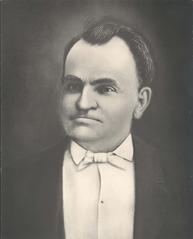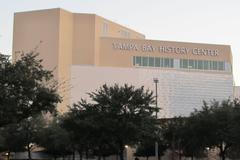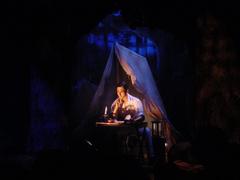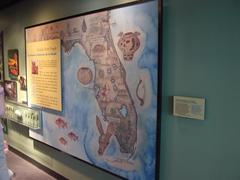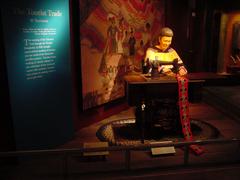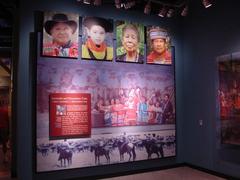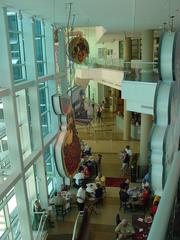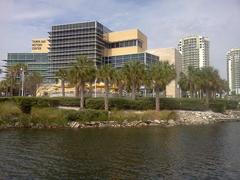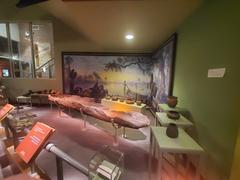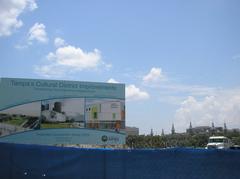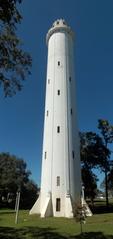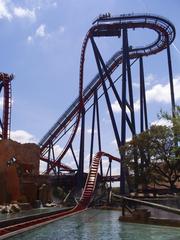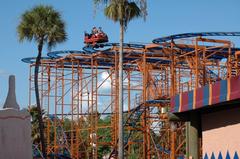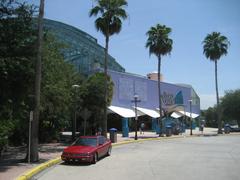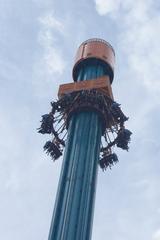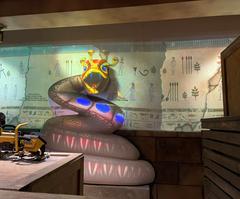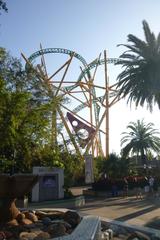
Visiting Tampa Bay History Center, Tampa: Hours, Tickets, and More
Date: 23/07/2024
Introduction
The Tampa Bay History Center (TBHC) is a vibrant cultural institution located in the Channelside District of downtown Tampa, Florida. Established in 2009, the center’s origins can be traced back to the early 1980s when local historians and community leaders recognized the need for a dedicated space to preserve and interpret the rich history of the Tampa Bay area. The creation of the TBHC was spearheaded by the Tampa Bay History Center Foundation, established in 1986, which worked tirelessly to bring this vision to fruition (source).
Housed in a state-of-the-art, 60,000-square-foot facility designed by Rowe Architects Incorporated, the TBHC is a testament to modern architectural design and sustainable practices, earning it LEED certification. The center boasts three floors of exhibit space, a museum store, a research library, and a waterfront event space, all designed to offer an immersive and educational experience for visitors of all ages (source).
The TBHC’s exhibits span over 12,000 years of Florida’s history, featuring permanent and temporary displays that cover a broad range of topics.
Table of Contents
- Origins and Establishment
- Architectural Significance
- Exhibits and Collections
- Educational Programs and Community Engagement
- Visiting Hours and Ticket Information
- Accessibility and Travel Tips
- Nearby Attractions
- Research and Preservation
- Awards and Recognition
- Future Plans and Expansion
- Frequently Asked Questions (FAQ)
Exploring the Tampa Bay History Center - Visiting Hours, Tickets, and Historical Significance
Origins and Establishment
The Tampa Bay History Center (TBHC) was established in 2009, but its roots trace back to the early 1980s when local historians and community leaders recognized the need for a dedicated institution to preserve and interpret the rich history of the Tampa Bay area. The center’s creation was driven by the Tampa Bay History Center Foundation, which was formed in 1986. The foundation’s efforts culminated in the opening of the center in a state-of-the-art facility located in the Channelside District of downtown Tampa.
Architectural Significance
The TBHC’s building itself is a testament to modern architectural design, blending seamlessly with the historic ambiance of the surrounding area. Designed by the renowned firm Rowe Architects Incorporated, the 60,000-square-foot facility features three floors of exhibit space, a museum store, a research library, and a waterfront event space. The building’s design incorporates sustainable practices and materials, earning it a LEED certification, which underscores its commitment to environmental stewardship.
Exhibits and Collections
Cigar City: Tampa’s Cigar Industry
The “Cigar City: Tampa’s Cigar Industry” exhibit explores the rise of Tampa as the cigar capital of the world in the late 19th and early 20th centuries. This exhibit features artifacts, photographs, and interactive displays that bring to life the stories of the immigrants who built the industry and the cultural impact it had on the region (source).
Treasure Seekers: Conquistadors, Pirates & Shipwrecks
“Treasure Seekers: Conquistadors, Pirates & Shipwrecks” delves into the maritime history of Florida, including the exploits of Spanish explorers and the legends of pirate lore. The exhibit includes a replica of a 16th-century Spanish galleon and artifacts recovered from shipwrecks off the Florida coast (source).
Florida’s First People
The “Florida’s First People” exhibit provides a comprehensive look at the indigenous cultures that inhabited the region long before European contact. This exhibit features artifacts such as pottery, tools, and ceremonial items, as well as interactive displays that allow visitors to explore the daily lives and traditions of Florida’s native peoples (source).
Educational Programs and Community Engagement
The TBHC is not just a repository of artifacts; it is also a vibrant educational institution. The center offers a wide range of educational programs for students, teachers, and the general public. These programs include guided tours, hands-on workshops, and lectures by historians and archaeologists. The center’s “History Adventure Camps” provide children with immersive experiences that combine learning with fun activities.
In addition to its educational programs, the TBHC is deeply committed to community engagement. The center hosts numerous events throughout the year, including cultural festivals, historical reenactments, and special exhibitions. One of the most popular events is the annual “Gasparilla Pirate Festival,” which celebrates Tampa’s pirate history with a parade, live music, and family-friendly activities.
Visiting Hours and Ticket Information
The Tampa Bay History Center is open daily from 10:00 AM to 5:00 PM. General admission tickets are priced at $14.95 for adults, $12.95 for seniors (60+), $10.95 for students, $10.95 for youth (7-17), and free for children under 6. Special discounts are available for military personnel and groups. Tickets can be purchased online or at the museum entrance (source).
Accessibility and Travel Tips
The TBHC is wheelchair accessible and offers accommodations for visitors with disabilities. Accessible parking is available, and service animals are welcome. It is recommended to wear comfortable shoes and bring a camera to capture the exhibits and scenic views of the waterfront (source).
Nearby Attractions
Visitors to the TBHC can also explore nearby attractions such as the Florida Aquarium, Sparkman Wharf, and the Tampa Riverwalk. These sites offer additional opportunities for cultural and recreational activities, making it easy to spend an entire day in the Channelside District (source).
Research and Preservation
The TBHC is also a vital resource for researchers and historians. The center’s Saunders Foundation Research Library houses an extensive collection of books, manuscripts, maps, and photographs related to Florida’s history. The library is open to the public and provides valuable resources for academic research, genealogical studies, and personal exploration of the region’s past.
Preservation is a key component of the TBHC’s mission. The center actively works to conserve and protect historical artifacts and documents, ensuring that future generations can learn from and appreciate the rich history of the Tampa Bay area. The TBHC’s conservation efforts include climate-controlled storage, professional restoration services, and digital archiving of fragile materials.
Awards and Recognition
Since its opening, the TBHC has received numerous awards and accolades for its contributions to the preservation and interpretation of Florida’s history. In 2010, the center was awarded the American Association for State and Local History’s Award of Merit, one of the most prestigious honors in the field of public history. The TBHC has also been recognized by the Florida Association of Museums and the Southeastern Museums Conference for its innovative exhibits and educational programs.
Future Plans and Expansion
Looking ahead, the TBHC has ambitious plans for expansion and growth. The center is currently working on a major expansion project that will add new exhibit space, a larger research library, and additional facilities for educational programs and community events. This expansion will allow the TBHC to continue its mission of preserving and sharing the history of the Tampa Bay area with an even broader audience (source).
Frequently Asked Questions (FAQ)
Q: What are the visiting hours for the Tampa Bay History Center?
A: The center is open daily from 10:00 AM to 5:00 PM.
Q: How much are tickets to the Tampa Bay History Center?
A: General admission tickets are priced at $14.95 for adults, $12.95 for seniors (60+), $10.95 for students, $10.95 for youth (7-17), and free for children under 6. Special discounts are available for military personnel and groups.
Q: Is the Tampa Bay History Center wheelchair accessible?
A: Yes, the center is wheelchair accessible and offers accommodations for visitors with disabilities.
Q: Are there any nearby attractions?
A: Yes, nearby attractions include the Florida Aquarium, Sparkman Wharf, and the Tampa Riverwalk.
Visit and Stay Up to Date
To plan your visit, purchase tickets, or learn more about the Tampa Bay History Center, visit their official website. Follow them on social media to stay updated on upcoming events and new exhibits. For a more interactive experience, consider downloading their mobile app for virtual tours and additional resources.
Conclusion
The Tampa Bay History Center stands as a cornerstone of the Tampa Bay community, offering an enriching and comprehensive exploration of Florida’s history. From its inception in the early 1980s to its establishment in 2009, the center has continually evolved to become a premier destination for history enthusiasts and casual visitors alike. The TBHC’s state-of-the-art facility, designed by Rowe Architects Incorporated, not only showcases the region’s rich historical tapestry but also emphasizes sustainable architectural practices (source).
With exhibits that span over 12,000 years, the Tampa Bay History Center provides a deep dive into the people, events, and cultures that have shaped Florida’s past and continue to influence its present and future.
